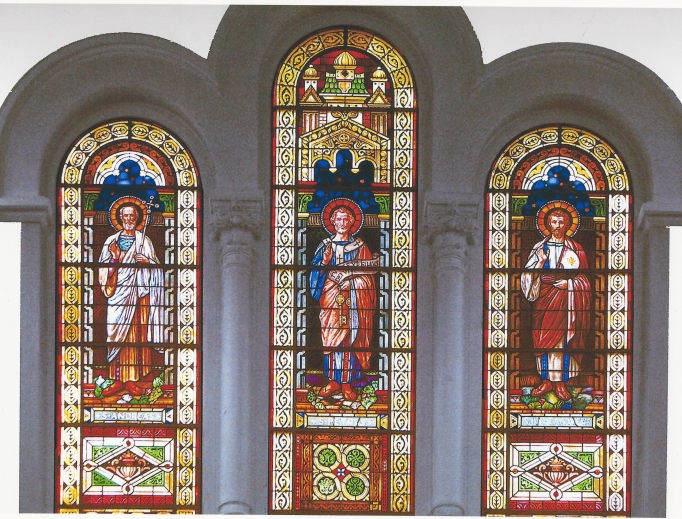Light of Faith: Meet the Workshop of Artists Behind the Vatican’s Stained-Glass Windows
Small, family-run business has created stunning pieces since 1900.

Entering St. Peter’s Basilica is a journey in and of itself. The final destination, Bernini’s Altar, is illuminated by the Dove of the Holy Spirit stained-glass window.
That famous window was made by a small, family-run workshop in Rome’s charming neighborhood of Trastevere.
The Vetrate d’Arte Giuliani workshop has produced other stained glass for the Vatican, such as in the Sistine Chapel, the Pope’s private chapel, Redemptoris Mater, and the Pauline Chapel, as well as around the world.
The studio’s extensive work portfolio ranges from the Royal Palace of Qatar and the Ecumenical Center of Abuja, Nigeria, to Sacred Heart University in Fairfield, Connecticut.
“We have done work privately, publicly, for churches, for banks, for singers, for actors, for everyone,” said Elsa Giuliani, the owner of 25 years, since after her husband died.
During the studio’s work inside the Vatican, the craftspeople created the personal coat of arms out of glass for many pontiffs and have had the opportunity to meet different popes. Pope Francis hasn’t asked for a coat of arms yet, “but we’re thinking of giving him one as a gift,” said Giuliani.
The shop was started in 1900 by Giulio Cesare Giuliani, a painter at heart and a chemist by trade. His passion and artistry, along with his scientific abilities, led his refined work to be known throughout Rome.
Giuliani’s craftsmanship is contributed to the materials and glass chosen from Germany. The stained glass is mouth blown from Lamberts, the only factory Giuliani could find that produces large panels, intentionally handcrafted from raw materials like sand, limestone and even gold.
Elsa Giuliani discloses the difficulty in restoring handcrafted work. She mentioned it is difficult to find mouth-blown glass in large quantities because most glass is pressed glass manufactured in China. Other companies that produce mouth-blown glass, for example Venetian glass, specialize in merchandise.
“Not as many people know about the glass artistry field,” she said.
The 118-year-old company continues to work in Italy and abroad, keeping the handcraft alive. Currently, the company is consulting with a church from Malta and also about a project in Cameroon, Africa.
“We really like to work abroad because, afterward, we feel that the work is esteemed,” Giuliani said.
The artists agree that every work is their favorite because each piece is different, and they place a lot of passion and enthusiasm into every project.
And those who have a handcrafted window esteem the workmanship.
“The superior craftsmanship and high quality of the colors in art, as well as the efficiency in insulation from the cold were unparalleled. It was clear that this was a company that was committed to quality, customized creations,” said David Coppola, former vice president for strategic planning and administration at Sacred Heart University and commissioner of the stained-glass windows in Sacred Heart University’s chapel.
“It takes a long time to learn the trade,” said Franco Galise, the firm’s chief technical designer. He has been working in the shop for 40 years. After studying computer science, Galise decided to follow in the footsteps of his father, who worked directly with Giuliani. “It is a craft handed down from father to son.”
The process begins by consulting with the client to determine the design, the dimensions and the cardinal direction of the window. After digitally designing the window, shades of color are chosen, depending on the direction of the sunlight. The stronger the light, the darker the color.
Coppola explained about the art and spiritual reflection of the glass in Sacred Heart’s chapel, saying, “When one enters at noon, the entire chapel is illuminated with the vibrancy of the Resurrection. As the daylight wanes, the walls take on a more reflective and warm feeling of home.”
As the artists work, there are 1,100 colors to select from when designing the windows. The artists explained that it is their job to find the perfect color for each piece of glass.
“When you build the image, you have to be very careful to reach harmony amongst the colors. It takes a lot of patience,” said Alessia Catallo, the house artist. She has been working at Vetrate d’Arte Giuliani for 16 years, after studying fine arts and metal work.
Next, the artists measure and cut the glass so that the contours reflect the life-size image. This is key for the proportions of the glass to be perfect when it is time to assemble.
Catallo paints the image on each piece of glass with a long, fine brush and a steady hand. She then places the glass on a large standing window to do the “grisailles,” which is a process of shading that gives dimension to the piece.


“This is a very delicate process, because every mistake can be revealed due to the transparency of the glass,” explained Galise.
Once the painting is complete, the glass is placed inside the oven for 10 minutes at 650 degrees Celsius (1,202 degrees Fahrenheit). This process is completed after every color is applied to the glass. Finally, the glass pieces are ready to be fit between precisely hand-cut steel strips and welded together.
For more than a century, the craftspeople at the small, stained-glass workshop resting on the cobblestone streets of Rome have revealed a most colorful story to observers of their windows.
“The colors wash onto the white walls during the day, making the reflection of the saints and angels seem to peacefully undulate with life,” Coppola recounted. “The overall effect is one of welcome, reflection, community and peace.”
Rachel Lanz is the journalism intern for EWTN in Rome. She blogs at NCRegister.com.
MORE INFORMATION
Take a look inside of Vetrate d’Arte Giuliani here: https://www.youtube.com/watch?v=JXuevL86dnY
- Keywords:
- catholic art
- rachel lanz
- stained glass
- vatican
















